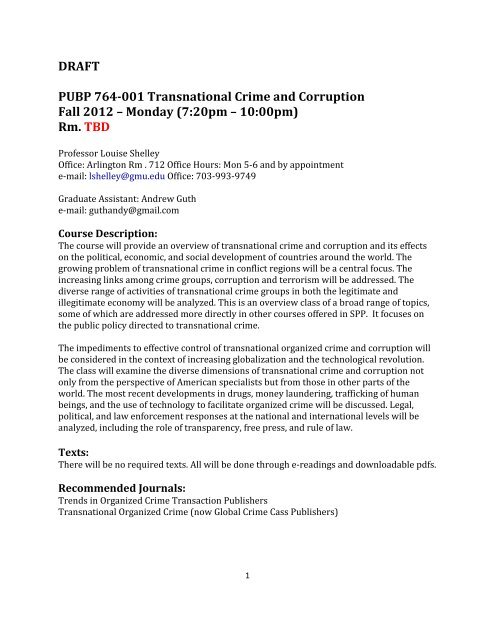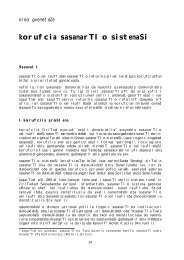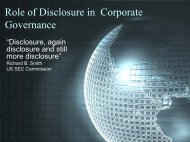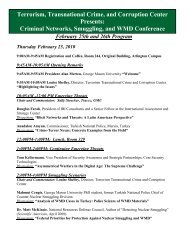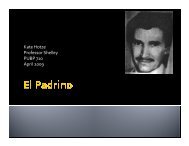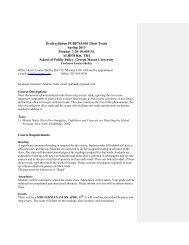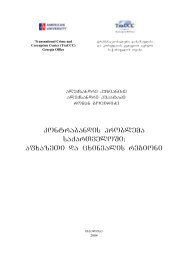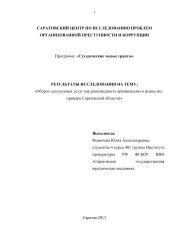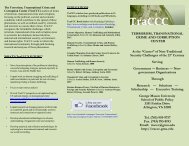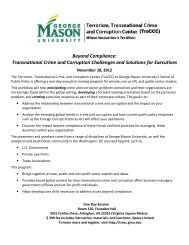Pubp 764.pdf - Terrorism, Transnational Crime and Corruption Center
Pubp 764.pdf - Terrorism, Transnational Crime and Corruption Center
Pubp 764.pdf - Terrorism, Transnational Crime and Corruption Center
- No tags were found...
Create successful ePaper yourself
Turn your PDF publications into a flip-book with our unique Google optimized e-Paper software.
economic development? How does it undermine the environment? How does it affecthuman rights, such as freedom of the press, labor rights, <strong>and</strong> the electoral process? Howdoes it affect women <strong>and</strong> the poor disproportionately? What is the impact on theenvironment? What is the impact of corruption on the foreign aid process? How does itlead to the prolongation of conflict?Required Readings:1) Louise Shelley, “<strong>Transnational</strong> Organized <strong>Crime</strong>: The New Authoritarianism,” in TheIllicit Global Economy, pp.25-6, 30-47 (see reserves)2) UNODC, Globalization of <strong>Crime</strong>: <strong>Transnational</strong> Organized <strong>Crime</strong> Threat Assessment,pp. 25-36; 173-93,http://www.unodc.org/documents/data-<strong>and</strong>-analysis/tocta/TOCTA_Report_2010_low_res.pdf3) Louise Shelley, Human Trafficking: A Global Perspective, ch. 2, pp.59-67; 76-8 (seereserves)4) Committee to Protect Journalists, Getting Away with Murder,http://www.cpj.org/reports/2012/04/impunity-index-2012.php#more5) Susan Breitkopf, “The Looting of Iraq’s Antiquities,”http://www.aam-us.org/pubs/mn/MN_JF07_lost-iraq.cfm6) Raymond Fisman <strong>and</strong> Edward Miguel, Economic Gangsters <strong>Corruption</strong>, Violence <strong>and</strong> thePoverty of Nations Princeton University Press, 2008, ch. 1, pp1-21 (reserves)Week 5: October 1 – <strong>Transnational</strong> <strong>Crime</strong> <strong>and</strong> Technology<strong>Transnational</strong> crime is able to function because there has been a decline of borders, a riseof ease of communications through the internet <strong>and</strong> advanced communications as well ashigh level facilitators. How does organized crime use the internet <strong>and</strong> encryption? Howdoes it market its goods through the internet? How does it use sophisticated computerspecialists to evade detection?Required Readings:1) Michael Glenny, McMafia: A Journey Through the Criminal Underworld, pp. 264-274(on cybercrime) (reserves)2) World Economic Forum (2012). “Organised <strong>Crime</strong> Enablers,” pp.8-13.http://www3.weforum.org/docs/WEF_GAC_Organized<strong>Crime</strong>Enablers_Report_2012.pdf3) Microsoft for Public Safety & National Security, “Malicious Software <strong>Crime</strong>,”http://www.microsoft.com/government/ww/safety-defense/initiatives/Pages/dcu-economiccrime.aspx4) UNODC, Globalization of <strong>Crime</strong>: <strong>Transnational</strong> Organized <strong>Crime</strong> Threat Assessment, p.203-218.http://www.unodc.org/documents/data-<strong>and</strong>-analysis/tocta/TOCTA_Report_2010_low_res.pdf5) Nicolas Christin, Traveling the Silk Road: A measurement analysis of a large anonymousonline marketplace. http://arxiv.org/pdf/1207.7139.pdf6) Ross Anderson, Chris Barton, Rainer Bohme, Richard Clayton, Michel J.G. van Eeten,Michael Levi, Tyler Moore, Stefan Savage (2012). “Measuring the Cost of Cybercrime,”http://weis2012.econinfosec.org/papers/Anderson_WEIS2012.pdf7
Week 6: Tuesday October 9 (Monday is a holiday) - <strong>Transnational</strong> <strong>Crime</strong> <strong>and</strong> ConflictRegions: Threat to Stability**Oral Presentations Start**<strong>Transnational</strong> <strong>Crime</strong> as a Security Issue: Overview<strong>Transnational</strong> crime is increasingly seen as a security threat. In the United States, the focusof concern is primarily on terrorism, whereas in the European context transnational crimeis more of a concern. The reasons for the divergence in this perspective will be analyzed. Inmany developing <strong>and</strong> transitional countries, the corruption of the military <strong>and</strong> lawenforcement <strong>and</strong> their involvement with organized crime <strong>and</strong> terrorist groups is a majorconcern to personal <strong>and</strong> national security. Regional conflicts are prolonged because of thecrime problem <strong>and</strong> rebel groups. In a world where regional conflicts have overtakensuperpower conflicts, the importance of transnational crime groups in financing <strong>and</strong>perpetuating regional conflicts has acquired increasing importance. What types of criminalactivity are most likely to support conflict? How does the illicit international arms tradecontribute to instability? How does corruption facilitate the transnational crime in conflictregions? What is the role of multinational organizations in this illicit activity?Required Readings:1) UNODC, Globalization of <strong>Crime</strong>: <strong>Transnational</strong> Organized <strong>Crime</strong> Threat Assessment, p.221-272.http://www.unodc.org/documents/data-<strong>and</strong>-analysis/tocta/TOCTA_Report_2010_low_res.pdf2) Woodrow Wilson <strong>Center</strong>, Organized <strong>Crime</strong> in Central America: The Northern Triangle,executive summary. http://www.wilsoncenter.org/sites/default/files/LAP_single_page.pdf3) DNI statement to Congress in Feb 2010 – “Growing Threat from InternationalOrganized <strong>Crime</strong>,” pp. 44-45.http://www.dni.gov/files/documents/Newsroom/Testimonies/20100202_testimony.pdf4) Rachel Locke, "Organized <strong>Crime</strong>, Conflict <strong>and</strong> Fragility: A New Approach, InternationalPeace Institute (2012), pp. 1-9.http://www.humansecuritygateway.com/documents/IPI_Organized<strong>Crime</strong>Conflict<strong>and</strong>Fragility.pdf5) Peter Gastrow, “Termites at Work” (Summary Report) pp.1-3.http://reliefweb.int/sites/reliefweb.int/files/resources/Full_Report_2562.pdfWeek 7: October 15 - Human Trafficking <strong>and</strong> SmugglingWhy is trafficking in human beings an increasingly severe problem? How does it differ fromother forms of organized crime? How does the smuggling <strong>and</strong> trafficking of men <strong>and</strong>women differ? How does trafficking in women differ by region? Why is it such a difficultcrime to investigate? What is required to combat this crime?Required Readings:1) Louise Shelley, “The Relationship of Drug <strong>and</strong> Human Trafficking: A Global Perspective”European Journal on Criminal Policy <strong>and</strong> Research: Volume 18, Issue 3 (2012), Page 241-253 (e-journals).8
2) UNODC, Globalization of <strong>Crime</strong>: <strong>Transnational</strong> Organized <strong>Crime</strong> Threat Assessment, pgs.39-77http://www.unodc.org/documents/data-<strong>and</strong>-analysis/tocta/TOCTA_Report_2010_low_res.pdf3) Jay S. Albanese, Human Trafficking chapter in <strong>Transnational</strong> <strong>Crime</strong> <strong>and</strong> the 21 st Century,pp. 49-65 (see reserves).4) Gastrow, P. (2011). "Human Trafficking <strong>and</strong> the Smuggling of Migrants." Termites atWork (Comprehensive Report), Chapter 4, pp. 59-73.http://www.google.com/url?sa=t&rct=j&q=&esrc=s&source=web&cd=1&ved=0CFQQFjAA&url=http%3A%2F%2Fkms1.isn.ethz.ch%2Fserviceengine%2FFiles%2FISN%2F138814%2Fipublicationdocument_singledocument%2Ff408c497-b334-4d33-93ea-5d6753d224b4%2Fen%2Fepub_1.pdf&ei=2H8pUJ6kOcqL0QHv4YGADw&usg=AFQjCNF6SIcoGVOGv2oHGb8-BQ_pG6xqzA&sig2=juXOHFx-8uKOoytxnoW5-gWeek 8: October 22 - Guest speaker? Drug TraffickingWhat is the nature of the drug problem? Why is it so prominent in the general problem oforganized crime? How do different criminal organizations work together to perpetuate thiscrime? How has the drug trade affected countries where the traffickers are a dominantpolitical <strong>and</strong> economic force? What are the new routes <strong>and</strong> new products?Required Readings:1) Woodrow Wilson <strong>Center</strong>, Organized <strong>Crime</strong> in Central America: The Northern Triangle(Dudley chapter, pgs. 18-61)http://www.wilsoncenter.org/sites/default/files/LAP_single_page.pdf2) World Drug Report for 2010, Executive Summaryhttp://www.unodc.org/documents/wdr/WDR_2010/Executive_summary.pdf3) UNODC, Globalization of <strong>Crime</strong>: <strong>Transnational</strong> Organized <strong>Crime</strong> Threat Assessment,chapters 4 <strong>and</strong> 5, pp.81-126.http://www.unodc.org/documents/data-<strong>and</strong>-analysis/tocta/TOCTA_Report_2010_low_res.pdf4) State Department's International Narcotics Control Report (2012), Volume 1, pp. 14-21<strong>and</strong> look at countries that may interest you. www.state.gov/j/inl/rls/nrcrpt/2012/5) Patrick Radden Keefe:a. Cocaine Incorporated, June 15, 2012,http://www.nytimes.com/2012/06/17/magazine/how-a-mexican-drug-cartelmakes-its-billions.html?pagewanted=allb. Interview with Keefe,http://6thfloor.blogs.nytimes.com/2012/06/18/behind-the-cover-storypatrick-radden-keefe-on-the-sinaloa-drug-cartel/6) <strong>Center</strong> for American Progress, the “High Costs of Afghan’s Opium Economy,”http://www.americanprogress.org/issues/2012/06/afghan_opium.html/9
Week 9: October 29 - Organized Environmental <strong>Crime</strong><strong>Transnational</strong> criminals function as important traders in endangered species, timber <strong>and</strong>CFCs pose major environmental threats <strong>and</strong> undermine sustainable development. They arealso active in the improper disposal of hazardous waste. They are also involved in illegalcarbon trading <strong>and</strong> defrauding programs for sustainable energy.Required Readings:1) UNODC, Globalization of <strong>Crime</strong>: <strong>Transnational</strong> Organized <strong>Crime</strong> Threat Assessment, pgs.149-169http://www.unodc.org/documents/data-<strong>and</strong>-analysis/tocta/TOCTA_Report_2010_low_res.pdf2) Gastrow, P. (2011). “Trafficking in Wildlife Products.” Termites at Work(Comprehensive Report). Chapter 3, pp.49-58.http://www.google.com/url?sa=t&rct=j&q=&esrc=s&source=web&cd=1&ved=0CFQQFjAA&url=http%3A%2F%2Fkms1.isn.ethz.ch%2Fserviceengine%2FFiles%2FISN%2F138814%2Fipublicationdocument_singledocument%2Ff408c497-b334-4d33-93ea-5d6753d224b4%2Fen%2Fepub_1.pdf&ei=2H8pUJ6kOcqL0QHv4YGADw&usg=AFQjCNF6SIcoGVOGv2oHGb8-BQ_pG6xqzA&sig2=juXOHFx-8uKOoytxnoW5-g3) Rob White, <strong>Transnational</strong> Environmental <strong>Crime</strong>: Toward an eco-global criminology,pp.1-18 (see reserves)4) Serious Organized <strong>Crime</strong> Agency (SOCA). SOCA Annual Report <strong>and</strong> Accounts 2011/12,p.20.http://www.soca.gov.uk/about-soca/library5) Climate Spectator (2011). “Double Trouble for Carbon Markets.”http://www.climatespectator.com.au/commentary/double-trouble-carbon-markets6) Interpol, “Electronic Waste <strong>and</strong> Organized <strong>Crime</strong>,” 2009, pp.33-37.http://www.google.com/url?sa=t&rct=j&q=&esrc=s&source=web&cd=1&ved=0CF0QFjAA&url=http%3A%2F%2Fwww.interpol.int%2Fcontent%2Fdownload%2F5367%2F45070%2Fversion%2F1%2Ffile%2FWastereport.pdf&ei=WIcpUOGQF8X06AHF_4GIBA&usg=AFQjCNHe6LyRv3DTXs7dBSTV_WWkASKk8Q&sig2=IoxnFfKV_g0_zXNhr2vrIARequired Videos:1) Carbon Credits video:http://www.eia-international.org.php5-20.dfw1-1.websitetestlink.com/ourwork/environmental-crime-<strong>and</strong>-governance/carbon-trade2) Earth Focus in Link TV, Baby Elephant Smuggling exposed,http://www.linktv.org/video/7852/baby-elephant-smuggling-exposedSuggested Readings:1) Traffic website—for more research done by Traffic see:http://www.traffic.org/general-topics/10
Week 10: November 5 - <strong>Transnational</strong> <strong>Crime</strong>, <strong>Corruption</strong> <strong>and</strong> <strong>Terrorism</strong>What linkages exist between transnational crime <strong>and</strong> terrorism? Do these relationshipsexist outside the drug trade? Why has the term narco-terrorism acquired such currency?Has their relationship changed over time? What are their differences in goals? Are theredifferences in funding?Required Readings:1) Louise Shelley, corruption chapter of book in progress (see reserves).2) Tamara Makarenko, “’The ties that bind’: uncovering the relationship betweenorganized crime <strong>and</strong> terrorism,” in Global Organized <strong>Crime</strong> eds. D. Siegel, H. van de Bunt<strong>and</strong> D. Zaitch, pp. 159-73 (see reserves).3) Michael P. Arena, “Hizballah’s Global Criminal Operations,” in Criminal-States <strong>and</strong>Criminal-Soldiers ed. Robert J. Bunker, pp. 126-42 (see reserves)4) John Rollins <strong>and</strong> Liana Sun Wyler, “International <strong>Terrorism</strong> <strong>and</strong> <strong>Transnational</strong> <strong>Crime</strong>”http://fpc.state.gov/documents/organization/141615.pdf, pp. 1-20.5) Louise Shelley, “Trafficking in Nuclear Materials: Criminals <strong>and</strong> Terrorists,” Global<strong>Crime</strong>, vol. 7, nos. 3-4 (August-November 2006), pp.544-560.6) Jeffrey Dressler (2012), Afghanistan Report 9, "The Haqqani Network," pp. 8-19, 39-41.http://www.underst<strong>and</strong>ingwar.org/sites/default/files/Haqqani_StrategicThreatweb_29MAR_0.pdfNovember 12 th - NO CLASSWe will make up this class during a study day.Week 11: November 19 - MIDTERM EXAMWeeks 12: November 26 - Business of <strong>Transnational</strong> <strong>Crime</strong> <strong>and</strong> Money LaunderingInternational organized crime groups <strong>and</strong> terrorists are now major actors in theinternational economy. What is money laundering <strong>and</strong> what are its stages? How is itaffected by increasing technology <strong>and</strong> the increasing sums of money involved? How isoffshore havens part of the regulatory problem? Why is it such an important part of thefight with organized crime?Required Readings:1) State Department 2012 International Narcotics Report, Part II: Money Laundering <strong>and</strong>Financial <strong>Crime</strong>s, pp.1-2. http://www.state.gov/j/inl/rls/nrcrpt/2012/2) Gastrow, P. (2011). Termites at Work (Comprehensive Report), pp. 89-102.http://www.google.com/url?sa=t&rct=j&q=&esrc=s&source=web&cd=1&ved=0CFQQFjAA&url=http%3A%2F%2Fkms1.isn.ethz.ch%2Fserviceengine%2FFiles%2FISN%2F138814%2Fipublicationdocument_singledocument%2Ff408c497-b334-4d33-93ea-5d6753d224b4%2Fen%2Fepub_1.pdf&ei=2H8pUJ6kOcqL0QHv4YGADw&usg=AFQjCNF6SIcoGVOGv2oHGb8-BQ_pG6xqzA&sig2=juXOHFx-8uKOoytxnoW5-g3) idefense, “Money Mules: Sophisticated Global Cyber Criminal Operations.”http://compliance<strong>and</strong>privacy.com/WhitePapers/iDefense_MoneyMules_20060329.pdf11
4) John Paul Rathbone, “Money Launderers: Taken to the Cleaners,” Financial Times. July20, 2012.5) Moisés Naím, Illicit: How Smugglers, Traffickers <strong>and</strong> Copycats are Hijacking the GlobalEconomy ch.7, pp.131-56 (reserves).6) Financial Action Task Force (FATF), Money Laundering Risks Related to Trafficking ofHuman Beings <strong>and</strong> Smuggling of Migrants, pp. 31-37. http://www.fatfgafi.org/media/fatf/documents/reports/Trafficking%20in%20Human%20Beings%20<strong>and</strong>%20Smuggling%20of%20Migrants.pdfWeek 13 <strong>and</strong> 14: December 3 <strong>and</strong> 10 - Combating <strong>Transnational</strong> Organized <strong>Crime</strong><strong>and</strong> <strong>Corruption</strong>What is the future of organized crime <strong>and</strong> what are the US <strong>and</strong> global strategies needed toaddress it? The class will address the strategies that are needed to combat thephenomenon in fragile states. We will also examine many other strategies that must be partof this strategy such as free <strong>and</strong> accountable journalism, following the money trail, <strong>and</strong>reducing dem<strong>and</strong> for illicit commodities. How can businesses become more involved incombating transnational crime? What can be done to combat the corruption that facilitatestransnational crime?Required Readings:1) White House, Strategy to Combat <strong>Transnational</strong> Organized <strong>Crime</strong> AddressingConverging Threats to National Security, pp.13-28.http://www.whitehouse.gov/sites/default/files/Strategy_to_Combat_<strong>Transnational</strong>_Organized_<strong>Crime</strong>_July_2011.pdf2) Rosemary Armao, “Covering <strong>Corruption</strong>: The Difficulties of Trying to Make aDifference,” Executive Summary <strong>and</strong> pp. 21-33 (role of journalists).http://cima.ned.org/sites/default/files/CIMA-Covering_<strong>Corruption</strong>-Report.pdf3) Rachel Locke, Organized <strong>Crime</strong>, Conflict <strong>and</strong> Fragility: A New Approach, InternationalPeace Institute 2012, pp.9-16.http://www.humansecuritygateway.com/documents/IPI_Organized<strong>Crime</strong>Conflict<strong>and</strong>Fragility.pdf4) UNODC, Globalization of <strong>Crime</strong>: <strong>Transnational</strong> Organized <strong>Crime</strong> Threat Assessment, pp.275-78. http://www.unodc.org/documents/data-<strong>and</strong>analysis/tocta/TOCTA_Report_2010_low_res.pdf5) Peter Andreas <strong>and</strong> Ethan Nadelmann, “The Internationalization of <strong>Crime</strong> Control,” in<strong>Crime</strong> <strong>and</strong> Global Political Economy, ed. H. Richard Friman, pp.21-33 (reserves).6) Michael Glenny, McMafia: A Journey Through the Criminal Underworld, pp. 343-46(reserves)7) E. Chris Johnson Jr., “Michigan Lawyers in the Fight Against Slavery,” Michigan BarJournal, June 2012, pp.22-26. (working with the business community <strong>and</strong> supply chains).http://www.michbar.org/journal/pdf/pdf4article2039.pdf8) Jay S. Albanese, in <strong>Transnational</strong> <strong>Crime</strong> <strong>and</strong> the 21 st Century , pp. 133-138 (reserves).12
9) Global Witness (2009). Ch. 9 “The Problem with the Financial Action Task Force,”“Conclusions <strong>and</strong> Recommendations.” Undue Diligence. Pgs. 105-123. http://www.unduediligence.org/Pdf/GW_DueDilligence_FULL_lowres.pdf10) UN campaign against transnational organized crime (Varies videos).http://www.unodc.org/toc/--campaign11) UN conventions on <strong>Transnational</strong> <strong>Crime</strong> (Varies treaties).http://www.unodc.org/unodc/en/treaties/index.html12) Vergara, J.C. (2012). “The Rebellion of Criminal Networks: Organized <strong>Crime</strong> in LatinAmerica <strong>and</strong> the Dynamics of Change. Woodrow Wilson <strong>Center</strong> update on the Americas,pp. 8-9. http://www.wilsoncenter.org/sites/default/files/Garzon.Rebellion.ENG__1.pdfTerm Paper Due: Monday Dec. 17th13


